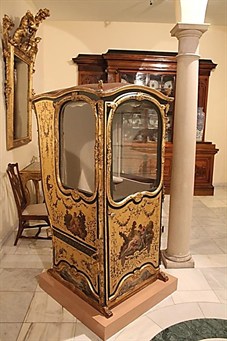Spanish Baroque furniture and its survival today
Furniture is an essential part of the cultural heritage of the Spanish Baroque, because it reflects the customs, tastes and interests of the society of the time. Nevertheless, much of the furniture from that period has been lost because the pieces were considered objects of common use, and therefore not deserving of the care and attention instead reserved to paintings or sculptures.
 In addition, the vulnerability of the materials with which they were made has increased the difficulty of the conservation of these objects. Private collections and museums have recovered, preserved and restored some of them to allow them to come down to us and allow us to rediscover, through their careful study, the importance of this heritage within the broader historical tradition in Spain. Individual pieces of furniture dating back to the Baroque are now preserved in various museums and Iberian palaces, including the Museo Nacional de Artes DecorativasThis museum contains the material culture of Spanish society, which enables us to interpret the ideas and values of its history. It is located in Madrid’s calle Montalbán. (National Museum of Decorative Arts) of Madrid and Barcelona, the National Archaeological Museum, the Museum of the City of Barcelona, private museums such as the Lázaro Galdiano Foundation or the Cerralbo Museum, and other buildings and noble’s residences scattered throughout Spain and open to the public.
In addition, the vulnerability of the materials with which they were made has increased the difficulty of the conservation of these objects. Private collections and museums have recovered, preserved and restored some of them to allow them to come down to us and allow us to rediscover, through their careful study, the importance of this heritage within the broader historical tradition in Spain. Individual pieces of furniture dating back to the Baroque are now preserved in various museums and Iberian palaces, including the Museo Nacional de Artes DecorativasThis museum contains the material culture of Spanish society, which enables us to interpret the ideas and values of its history. It is located in Madrid’s calle Montalbán. (National Museum of Decorative Arts) of Madrid and Barcelona, the National Archaeological Museum, the Museum of the City of Barcelona, private museums such as the Lázaro Galdiano Foundation or the Cerralbo Museum, and other buildings and noble’s residences scattered throughout Spain and open to the public.
However, it is important to remember that the furniture which has come down to our day belonged in large part to the nobles, hidalgos or to the Spanish royal family, being not only objects actually used in Baroque houses, but also accessories that showed visitors the power and wealth of the family that possessed them, even more so when these furnishings were imported from other countries – such as Italy, France or Germany – or had very specific styles and decorations – perhaps coming from totally different cultural contexts, such as the Far East.
The furniture presented in the following pages could not be lacking in any aristocratic house of the Baroque era: beds, desks, chairs, lamps, braziers, mirrors and many other objects that still retain the same shape and have the same decorations, present in modern homes following the model of the Baroque style. All photographs used depict pieces from the collection of the National Museum of Decorative Arts in Madrid.
